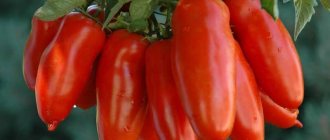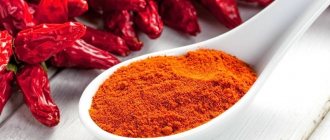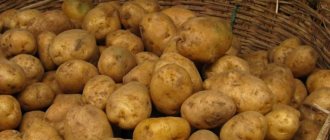Paprika can rightfully claim to be one of the most famous seasonings in the world. The red powder has a sweetish taste with piquant, bitter notes and is widely used in cooking.
The raw material for the production of paprika is sweet pepper. Its Latin name is Capsicum annum, and in Russian it is also called paprika. Its fruits, after ripening, are dried and then crushed into powder.
Historical reference
Paprika is native to South America. Red peppers were brought to Europe by Spanish conquistadors in the 16th century. They called the seasoning “Indian red salt.”
The new spice quickly gained popularity, mainly because it was not too expensive. The thing is that ground black pepper at that time was literally worth its weight in gold - and therefore was used exclusively by chefs of the nobility. Paprika turned out to be much more accessible.
Content:
- Historical reference
- Botanical characteristics
- Types of seasoning
- Chemical composition and calorie content
- Beneficial features
- Contraindications for use
- Use in cooking
Today, one of the main producing countries of this seasoning is Hungary. The country produces seven varieties of paprika, which differ from each other in color, pungency and aroma. Hungarians often call paprika “red gold” and it is present as an essential ingredient in many Hungarian dishes.
What is red pepper
Hot red peppers come from America. This is the same crop that was brought by Spanish sailors who went for Indian spices, but by coincidence discovered a new continent.
The shape is not as varied as that of sweet peppers. Often the fruits are round or elongated. The color is yellow, red or dark olive. In Russia, the most common peppers are red, resembling a proboscis.
Culture loves sun and warmth. The ideal environment for growth is greenhouses. If desired, the plant can be grown at home on a windowsill.
The substance capsaicin gives the fruit its characteristic burning taste. The more of it, the hotter the red pepper. The fruits contain:
- carotenoids;
- calcium;
- fixed oils;
- sulfur;
- iron;
- B vitamins;
- ascorbic acid.
Thanks to its rich chemical composition, red pepper has a powerful effect on the body and enhances the effect of medications.
Hot peppers are contraindicated for people suffering from diseases of the heart, kidneys, liver and gastrointestinal tract.
What is the difference between paprika and red pepper?
Are paprika and red pepper the same thing? Our answer is yes! Spices are made from a single plant. The only difference is the degree of spiciness. The fruits of sweet paprika are not spicy or have a slight pungency. Once dried, the pepper is turned into powder or flakes. The taste of the spice depends on the drying method.
There is smoked paprika on sale, which has a pronounced aroma. Hot red pepper is often added to sweet pepper powder. This enhances the taste and adds piquancy.
Ground red pepper is made from hot paprika. The spice is used in cooking, medicine and cosmetology.
What is the difference between paprika and bell pepper
Bell pepper, sweet pepper, paprika are the names of the same culture. Paprika means "pepper" in Hungarian. There are many varieties of paprika in the world of different colors, shapes and sizes, with different taste characteristics and degrees of spiciness.
In Russia, the most popular is bell pepper with thick skin and pulp. In Italy, they prefer the sweet fruits of Peperoncino or Cubanelle, with a thin skin and a fragrant aroma. Spaniards love the hot cone-shaped Piquillo peppers or the sweet Pimento peppers with their delicious aroma and thin skin.
Reference. All varieties of paprika are suitable for making seasoning in powder or flake form.
Botanical characteristics
As noted above, the raw materials for the production of paprika are the fruits of the plant of the same name. In its cultivated form, paprika is an annual plant, and in the wild it is a perennial erect shrub of the Solanaceae family, which can reach one and a half meters in height.
Paprika blooms with large white flowers with purple, green or pale yellow veins. Flowers can be single or collected in bunches.
Paprika fruits are hollow, false berries containing a large number of seeds. The color of the fruit can vary - they are not only red and orange, but also yellow, green and brown.
Today, paprika is cultivated in some European countries (primarily Hungary and Spain), Turkey, and also in the USA.
Recipes with spice
The spice goes well with different dishes - cold, hot, first and second, salads and appetizers... What dishes can paprika seasoning be used for? This list is almost endless! We have prepared two simple recipes that will help significantly diversify your daily menu.
Fresh salsa makes a great appetizer
- Dice two tomatoes;
- Chop the red bell pepper and half the red onion;
- Stir and add a bunch of chopped parsley;
- Salt, add a teaspoon of spice and a pinch of black pepper;
- Pour in a tablespoon of lemon juice and stir again.
Lavash chips - a healthy snack
- Take three sheets of Armenian lavash and cut it into small slices;
- Place the squares on a baking sheet and evenly sprinkle a teaspoon of spice, the same amount of basil, add salt to taste;
- Drizzle olive oil and toss sheets;
- Place in the oven at 180 degrees and stir every 5-7 minutes until browned.
We have studied in detail what ground paprika seasoning is, what features it has and how to use it correctly. We hope that our review helped you understand the issue and revealed a lot of interesting information that will certainly be useful to you in the kitchen.
Types of seasoning
As noted above, today one of the main producers of paprika is Hungary. The country produces seven main varieties of the popular seasoning. The main difference between them is the color, the size of the grinding fractions and the sharpness.
How hot paprika is depends on the quantity of pod membranes and seeds containing the alkaloid capsaicin, which has an extremely hot taste, used in its production.
The main types of paprika are:
- Noble sweet paprika. It is distinguished by medium grinding, a rich dark shade and a pleasant aroma.
- Semi-sweet seasoning of medium heat, light in color, with a very rich aroma.
- Spicy yellowish seasoning. Its grind is medium, and the taste is sharp and burning.
- Delicate paprika. It is light red in color with a distinct matte tint, and the taste of this species is rather spicy than spicy.
- Delicious paprika of bright red color. It is not too spicy, and chefs love it because it helps to reveal the original taste of the dish thanks to its subtle aroma.
- Special paprika is bright red, with a very mild, slightly sweet taste.
- Pink paprika is not actually pink, but a light red color. It is medium ground, very piquant and boasts a spicy taste and pleasant aroma.
In Hungary itself, hot paprika is the most popular - it is considered a kind of “trick” of the national cuisine.
Paprika seasoning: description and features
Paprika is a spice that comes in a bright red powdery consistency. The seasoning has a spicy, sweetish taste, a pleasant peppery aroma and a slightly spicy aftertaste. Depending on the place of production, paprika is a seasoning with a pronounced sweet taste or with the addition of subtle hot notes.
This seasoning did not come to us right away. South America is considered to be its birthplace. First, the spice was brought to Hungary, where it was appreciated and began to be used for culinary purposes. Then the fame of paprika spread to other countries. Today, paprika production has been launched in countries such as Spain, the USA, Turkey, Mexico, and Germany. From these and other countries where the aromatic seasoning is produced, paprika reaches many parts of the world. After all, the spice is valued almost everywhere. In grocery stores and markets in our country, you can easily buy a bag of paprika, and not pay such a high price. Paprika is a spice from the list of available products.
What is paprika made from and where is it added?
Have you ever wondered what paprika is made from? Pepper forms the basis for the preparation of this bright and aromatic seasoning! Sweet peppers of special varieties are used as raw materials for its production. This is a plant of the Solanaceae family. It grows in places with a predominantly warm climate.
Ripe fruits, depending on the variety, have a bright orange or purple-red color. Paprika pepper can be either rich yellow or brown. The level of heat of this pepper also depends on the variety. However, it is worth saying that paprika is a spice that is not unbearably hot. The bitterness in this seasoning is soft, unobtrusive, as if standing in the background after color, aroma and enveloping sweetness.
Paprika production is a rather labor-intensive and time-consuming process. To obtain a red suspension, peppers are grown, waited until they are fully ripe, and then the perfect fruits are selected. The entire marriage is eliminated. Because real paprika is a seasoning made from selected ripe peppers. So, after culling, the peppers are dried and mechanically ground to obtain a bright red, rich in flavor and aroma, spicy powder.
Then comes the packaging process. So that the spice does not lose its attractive aroma and the taste does not deteriorate, the product is hermetically packaged in a paper, film (cling film) or plastic base. You can often find seasoning sold by weight. And this option has the right to life. However, it is worth considering how high quality this spice is, how long and correctly it was stored before sale.
Chemical composition and calorie content
The energy value of dried paprika is 358 kcal per 100 g of product. The nutritional breakdown is as follows: 14.1 g protein, 12.8 g fat and 34 g carbohydrates.
Of course, you should not overuse paprika, like other seasonings. And, nevertheless, nutritionists recommend using it to emphasize the taste of dishes, and at the same time enrich them with useful substances.
The chemical composition of paprika contains vitamins, minerals, and essential oil.
Chemical composition: vitamins
| Vitamin A | 3560 IU |
| Vitamin C | 4.8 mg |
| Vitamin E | 2.0 mg |
| Vitamin K | 5.4 mcg |
| Vitamin PP | 1.0 mg |
| Vitamin B6 | 0.3 mg |
| Vitamin B9 | 7.2 mcg |
It is noteworthy that the vitamin C content in paprika is higher than in citrus fruits. A powerful antioxidant increases the human body’s resistance to viruses and bacteria, regulates metabolism, and accelerates regeneration processes.
Vitamin A is also necessary to keep the immune system functioning. In addition, it plays the “first violin” in redox processes in the body, necessary for normal cell division. It is also indispensable for maintaining the human reproductive system in a healthy state.
Vitamin E improves the condition of blood vessels, strengthens them, making them more elastic. It also increases the overall tone of the body and helps reduce blood sugar levels. In addition, this substance accelerates wound healing.
Vitamin K plays an important role in regulating blood clotting. It also protects against a serious disease, osteoporosis, by helping to maintain healthy bone tissue. This vitamin is also necessary for blood vessels - it prevents their calcification, in other words, hardening due to calcium deposition.
Vitamin PP acts as an anticoagulant, preventing the formation of blood clots. In addition, it significantly lowers the level of “bad” cholesterol in the body, reducing the risk of a heart attack. In addition, it stimulates the synthesis of pancreatic enzymes and helps the body absorb protein from plant foods.
Vitamin B6 is necessary for the prevention of nervous disorders. It also acts as a natural diuretic and helps normalize blood sugar levels.
Vitamin B9 is necessary for pregnant women for normal fetal development.
In addition, it has a beneficial effect on the digestive system and helps cope with stress. Chemical composition: macro- and microelements
| Calcium | 11.9 mg |
| Iron | 1.6 mg |
| Magnesium | 12.5 mg |
| Phosphorus | 23.3 mg |
| Potassium | 158 mg |
| Sodium | 2.3 mg |
| Zinc | 0.3 mg |
Calcium is responsible for the condition of bone and dental tissue. In addition, it is involved in the processes of regulating blood clotting, has anti-inflammatory properties, and is involved in the synthesis of a number of enzymes.
Iron plays the “first violin” in the process of hemoglobin formation. It also increases the overall resistance of the body and is involved in the synthesis of thyroid hormones. In addition, it helps the body absorb externally supplied vitamin B.
Magnesium prevents the formation of stones in the gall bladder and kidneys, maintains healthy teeth and the digestive system, and helps remove toxins and heavy metals from the body.
Phosphorus plays an important role in energy metabolism and is necessary for maintaining healthy bone and dental tissue in the body, as well as for mental activity.
Potassium helps maintain normal water balance in the body, preventing the appearance of edema. In addition, it is critical for maintaining a normal heart rate. This element also has antihistamine properties.
Sodium is necessary to maintain normal water-salt balance in the body. It also takes part in the production of gastric juice and has a vasodilating effect.
Zinc is necessary for the prevention of diabetes. It also prevents the development of epilepsy, accelerates tissue regeneration, stimulates cognitive activity, improves the condition of the skin and hair, normalizing the functioning of the sebaceous glands.
Bell pepper - description
Sweet pepper is a very tasty and healthy vegetable that can be consumed in any form all year round. You can buy it or grow it yourself in your garden. Despite the fact that we are accustomed to calling it “Bulgarian”, the birthplace of this fruit is Central America. Cultivated sweet peppers were not brought to Bulgaria right away: first they visited Portugal and Turkey and only then reached the country with which we are accustomed to associate this vegetable. It was from Bulgaria that the “sweet pepper” (as the Bulgarians themselves called it) first came to the south of Russia. This happened back in the 17th century.
For reference
: according to another opinion, sweet pepper came to our country through Turkey and Iran back in the 16th century.
At first, this crop was grown directly in the southern climatic zones, but gradually, with the advent of varietal diversity, peppers penetrated deep into the country, and then reached the most extreme northern points, where peppers are grown indoors. This was facilitated by the fact that, as it turned out, this crop is extremely unpretentious to growing conditions. Yes, peppers love warmth and plenty of sunlight, but this can always be achieved artificially. It so happened that having learned the basics of agricultural technology for such a southern vegetable as pepper, even northerners tasted all the benefits and freshness of the bright, rich taste of this super vegetable.
For reference
: Italy, Greece, Bulgaria, Spain and Hungary are the countries producing Bulgarian vegetables for export.
Everyone knows the beneficial properties of bell pepper. It helps maintain health and is also included in therapy in the treatment of many diseases. The vegetable contains a large amount of vitamins (A, E, K, P, C, B1, B3, B2, B6, B5, B9).
Bell peppers contain a huge amount of vitamin C, even more than black currants and lemon. And it contains the same amount of vitamin A as carrots.
It also contains many microelements, such as iodine, zinc, calcium, potassium, phosphorus, iron, sodium and other substances beneficial to human health.
What are the benefits of bell pepper:
- improves immunity;
- protects against colds;
- strengthens the body as a whole;
- prevents the development of cancerous tumors;
- improves blood composition, strengthens the cardiovascular system;
- normalizes digestion;
- improves metabolism;
- good for vision;
- promotes the production of endorphins. Indicated for stress, depression, fatigue;
- improves memory;
- improves the condition of hair and nails;
- helps cope with excess weight;
- ointments and creams often contain pepper, which helps cope with radiculitis and arthritis;
- included in vitamins to preserve youth.
note
: the calorie content of sweet pepper is only about 25 kcal per 100 grams of product.
Botanical description
Externally, bell pepper has very attractive characteristics: the fruit has optimal dimensions (fits in the palm of your hand), is brightly colored, and its skin is thick, dense, smooth, and crispy. Peppers have a juicy, fresh taste and a bright, rich aroma.
Bell peppers, like tomatoes and eggplants, belong to the nightshade family. Wild pepper is a perennial plant, whereas we are used to planting it as an annual crop. Today there are tens of thousands of different varieties of sweet peppers, which have differences in the shape and taste of the fruit, their parameters, plant types, etc.
Pepper plants come in different heights (short, medium-sized and tall - depending on the variety), with sparse branches spread out. The leaves are large, ovate. Pepper blooms from June, bears fruit from July to October (November). It produces fruits that are predominantly cone-shaped and cubic in shape. In general, the fruits are large, thick, strong, and hollow inside. The length of the fruit reaches 20 centimeters. Plants have the ability to pollinate themselves and produce multi-seeded fruits of different shapes and colors.
Interesting Facts:
There are several types of bell pepper. Thick-skinned, fleshy varieties have taken root in our country:
- red is the sweetest;
- yellow – juicy, less sweet;
- green - with a simple viscous taste;
- black – tastes like green, the only difference is the color.
- in Europe these peppers are called “swei”.
Italians prefer to have sweet peppers cubanelle and peperoncino on their tables - their skin is thin and their shape is slightly elongated.
According to many people, paprika (also called Hungarian pepper) is another variety of sweet pepper from which the famous seasoning is made.
You may be interested in: Favorable days for picking pepper in 2021 according to the lunar calendar Favorable days for planting pepper for seedlings in 2021: terms and rules for sowing at home Favorable days for sowing sweet and bitter pepper for seedlings in 2021
The Spanish variety of peppers is called piquillo. The fruits are thin-barked and very long. When eaten raw, it tastes like piquillo.
The sweetest and most delicate peppers are called “pimento” - these are small fruits shaped like a heart.
Beneficial features
Paprika owes its beneficial properties to the peculiarities of its chemical composition:
- The seasoning improves the functioning of the digestive system. In particular, it stimulates the synthesis of pancreatic enzymes, improves intestinal motility, preventing constipation. It is also useful for flatulence, colic, and accumulation of gases in the intestines.
- The active substances present in paprika have a beneficial effect on the condition of blood vessels. They also reduce blood clotting, thereby reducing the risk of blood clots.
- Paprika increases the body's resistance to viruses and bacteria.
- This seasoning helps to “accelerate” metabolism, and therefore is useful for excess weight.
What does paprika look like?
When going to the market, it’s worth having an idea of what real paprika looks like. The seasoning, as already mentioned, is a rich red powder. Interspersed with yellowish and juicy orange tints are acceptable. This indicates the variety of peppers. The spice instantly scatters when you blow on it. It does not crumple or flake if you touch it. Paprika dissolves well in water, giving the liquid a rich tint.
Where is paprika added?
We are looking at one of those spices that can truly revolutionize the culinary art! If you find a bag of paprika in the kitchen, then your culinary efforts will definitely not be in vain. After all, this spice is both a dye and an aromatic flavoring additive in one “bottle.” This spice is added to a huge number of dishes.
You can find paprika in:
- vegetable pilaf or risotto;
- it goes well with pasta and pizza;
- Paprika is appropriate in vegetable salads, or rather, dressings;
- it is added to soups and stews;
- seasoning gives a beautiful shade to sauces and marinades;
- it goes well with many main courses.
It is not possible to list all the options for culinary compositions in which paprika is at least appropriate, and at most plays one of the leading roles. This spicy additive is very widely used in cooking. And, by the way, this is also good because the seasoning is famous for its many useful qualities. After all, paprika contains a very large amount of bioactive substances, vitamins, and minerals.
Contraindications for use
However, paprika, like other seasonings, has contraindications. So, you should not get carried away with it if you have been diagnosed with coronary heart disease, and heart rhythm disturbances are also recorded.
Paprika is not recommended if you are prone to hypertension, as well as with nervous overexcitation.
Contraindications to the use of paprika are also some diseases of the digestive system - in particular, stomach ulcers, gastritis with high acidity, ulcerative colitis, cholecystitis and acute pancreatitis.
Paprika can also cause an allergic reaction in case of individual intolerance.
What can I substitute in recipes?
The spice has a unique smoky aroma and pungent taste and is an essential component of many dishes, revealing their characteristics. If you don’t have the much-needed ground ingredient at hand, you can try to find analogues:
- Cayenne pepper. Use with caution due to the spiciness and be sure to add sugar, honey or a little cream to level out the taste;
- Chili pepper. Put in small quantities;
- Black and white peppers can be combined with tomatoes - this will give you a red color and a spicy note;
- Red pepper , like chili, should be added little by little.
Now you know exactly what paprika is and what you can replace it with - write down our little secrets to get out of a difficult situation and not stop cooking. Finally, we have prepared some interesting recipes that benefit from the presence of dried paprika.
Use in cooking
Paprika is widely used in the preparation of dishes of several national cuisines: Spanish, Mexican, Indian, Moroccan and, of course, Hungarian. It is precisely this that is an integral component of paprikash, one of the most famous delicacies in Hungary. Chicken or veal meat is first fried and then stewed with sour cream and spices, the main one of which is paprika. Hungarians also often add paprika to mashed potatoes, which ultimately acquires a reddish color, a spicy taste and a pleasant aroma.
An interesting fact: according to statistics, the average Hungarian person eats 0.5 kg of paprika per year. Moreover, in the Balkan countries neighboring this country, this figure is 200 g, and in Germany - about 100 g. Also, Hungary is the only country where there is a unique paprika museum.
This spice can make even the most ordinary dishes sparkle in a new way - soups, sauces, rice, salads and even cottage cheese. It goes well with different types of meat, primarily chicken and pork, as well as cheese, fish and seafood. This seasoning is always included in barbecue mixtures, as it gives dishes prepared in this way a special sweetish flavor and spiciness.
As for seasonings, paprika can be combined with coriander and basil. A harmonious combination of paprika with garlic, savory, and bay leaf. Paprika also plays well “in a duet” with chili, giving the dish a unique taste that brings to mind Latin America.
Most often, paprika is used if the main component of the dish has a characteristic taste that is easy to drown out with other spices. For example, culinary experts know that paprika is the best seasoning for cooking salmon, while ordinary black pepper can change the taste of this fish literally beyond recognition.
There is an important nuance that must be taken into account when using paprika. It cannot be subjected to prolonged heat treatment, since in this case it burns and gives the dish a rather unpleasant bitterness. Experienced cooks therefore resort to a trick: they often mix paprika with a slightly preheated tomato, and then add this mixture to the main dish at the final stage of its preparation.
If there is no tomato in the recipe of the dish, you can add ground paprika only after you have already removed the pot or pan from the heat. After this, cover the container with a lid and let stand for five minutes. During this time, the spice will be able to “open up”.
It is also important to consider that paprika is absolutely not compatible with some products. This is, first of all, fresh cilantro and onions.
Smoked paprika
The highlight of many Spanish dishes is a very special type of this seasoning - smoked dried paprika. It has a unique aroma and gives the dish a very refined and stylish taste.
Smoked paprika is produced from regular ripe paprika. First, its fruits are dried and then smoked. To do this, paprika is placed in special two-tier dryers. Pepper is placed on the second “floor”, and on the first there are smoldering oak logs.
The process of smoking paprika is long - it takes more than two weeks. The finished smoked paprika is then crushed into powder, packaged and placed on store shelves.
Smoked paprika powder is red in color with a golden tint. This seasoning goes well with grilled dishes, baked potatoes, rice and vegetables, as well as smoked meats. In Spain, it is also added to the legendary delicacy - chorizo sausage.
There are three types of smoked paprika: sweet, semi-sweet and hot. The sweet variety is especially popular. Its taste is practically not pungent, but it still boasts a unique aroma. In Spain and Mediterranean countries, sweet smoked paprika is added to tomato sauces and soups, as well as rice and fish.
You can prepare smoked paprika at home. If all technological subtleties are observed, it turns out to be as aromatic and tasty as factory-produced paprika. To prepare this spice, you can use one of several methods.
The easiest way to prepare smoked paprika is if you have a smoker. Wood chips should be placed on the bottom, preferably oak. Fresh paprika fruits are cut into two halves and smoked for three days. To ensure that they are smoked evenly, they are turned over from time to time. Please note that the smoking temperature should not exceed seventy degrees.
If you don't have a smokehouse, you can use a grill. A container with oak chips is placed at the bottom, a grate is placed on top, and peppers are placed on it. Smoke paprika on the grill covered, maintaining a constant temperature at 50-60 degrees.
A multicooker for smoking paprika is also suitable if it has a “hot smoking” mode. Don't forget to add a handful of sawdust to the bowl. The peppers themselves are placed on the grill and smoked for forty minutes.
Finally, you can cook smoked paprika in a saucepan, which will serve as an impromptu smokehouse. Place wood chips on the bottom, cover them with foil, and place a round grill with peppers on top. Cover the grill with a kitchen towel, close the pan with a lid and cook under pressure.
Cooking chicken with sweet peppers and smoked paprika
To prepare this dish you will need 4 chicken legs, the same number of sweet bell peppers, 50 ml olive oil, a head of red onion, 100 ml dry white wine, 0.5 l chicken broth, 50 ml 10% cream, a teaspoon of smoked paprika , salt and ground black pepper to taste.
Using a large sauté pan, fry the chicken legs in olive oil until golden brown. After this, remove them from the saucepan and set them aside.
In the same container, fry finely chopped onion until soft. After this, add sweet pepper cut into large strips. Season with salt and pepper. Simmer, stirring constantly, for three minutes. After this, pour in the wine and cook over low heat until it has completely evaporated.
Add broth to vegetables, add paprika. Place chicken legs on top and cover with a lid. Simmer for twenty-five minutes.
Strain the broth into a blender, add a few slices of stewed pepper and cream. Prepare the sauce.
Cooking perkelt with turoshchusa
The recipe for this Hungarian dish, which is a combination of two dishes at once, is quite complex. However, the food itself may also seem very unusual to those who are new to the culinary traditions of Hungary.
Best materials of the month
- Coronaviruses: SARS-CoV-2 (COVID-19)
- Antibiotics for the prevention and treatment of COVID-19: how effective are they?
- The most common "office" diseases
- Does vodka kill coronavirus?
- How to stay alive on our roads?
To prepare you will need the following ingredients: 3 kg of veal, two sweet peppers, 150 g of lard, a glass of dry red wine, two heads of white onion, five tablespoons of dry paprika, two cloves of garlic, 350 g of wide noodles, 400 g of cottage cheese, 230 g sour cream, salt, cumin, white and black pepper to taste.
Finely chop the onion and bell pepper. Throw the lard, cut into small pieces, into a saucepan and fry it for twenty minutes over low heat until a crust appears. The cracklings will be used for garnish, and the meat will be stewed in the rendered fat.
Cut the veal into cubes measuring three by five centimeters. Place the onion in the fat formed when cooking the greaves. It should be thoroughly soaked, so if there is little fat, add vegetable oil. Fry until the onion becomes transparent, then add the chopped meat to it.
Add chopped garlic, black and white pepper, cumin. Stir thoroughly. Mix paprika with olive oil to form a kind of paste. Add it to the meat. Simmer the veal for one and a half hours. Ten minutes before it is ready, pour in a glass of wine.
Boil the noodles in salted water. Pour cracklings into it. Mix cottage cheese with sour cream and add to noodles and cracklings. When serving, place the meat (perkelt) on one half of the plate and the noodles (turoshchusu) on the other.
How to cook it yourself
The question of how to make paprika at home is quite interesting - the manufacturing process is not as complicated as it might seem at first glance. You only need one ingredient that is available to everyone - and then you need to remember the sequence of simple steps:
- Take two kilograms of pepper;
- Rinse, remove the core and completely remove the seeds;
- Cut into small pieces and place on a baking sheet;
- Place the baking sheet in the oven over low heat and wait until completely dry;
- Place the dried pieces into a blender or coffee grinder and grind into powder;
- Sift through a sieve and pour into a glass jar, close the lid tightly and put in a dark place.
Please note that the best peppers are fresh, sweet ones that have recently ripened and have not had time to dry out on their own.
What to do if you didn’t have time to prepare the spice and didn’t buy a bag in the store, how to replace paprika in the recipe? We have the answer to this question!
Interesting facts about paprika
- Hungarians are true connoisseurs of this spice. And these are not just sentiments, statistics speak in their favor. It is estimated that the average resident of this country consumes about half a kilo of paprika during the year, while their neighbors in the Balkans barely manage 200 grams of the spice!
- To be fair, it should be mentioned that Hungarians do not eat all the paprika that is produced in their country. They are happy to share their national heritage with other countries, supplying them with 10 to 13 tons of spices annually.
- If you are in this country, be sure to visit the Paprika Museum in the town of Kalochi, which has no analogues in the world.
- It is interesting that initially vegetable peppers were only spicy - but until the Hungarian Palffy brothers thought of removing the hot veins from pepper fruits in the middle of the 19th century. This is how they managed to produce a non-hot spice, and then breeders developed the first sweet varieties of the plant.
- Spanish monks invented smoking paprika. It was they who guessed to dry peppercorns near lit fires and give them a tart smell of smoke. After 3 weeks, religious lovers of the spice had a red powder with an amazing smoky aroma.
Have you tried paprika with smoke? What do you think of this spice? Is it included in your daily diet? Well, or at least it came into your kitchen once?
Reviews
Christina. Very interesting and informative, information on this subject varies greatly. Now it became clear to me why, when buying the same seasoning, sometimes I get different results. I’ll take a closer look at the description on the packaging; my family doesn’t like spicy foods. I would like to find spicy paprika, I think it adds a special piquancy to dishes without being spicy.
Denis. There have been so many conversations about this. I was sure that paprika has nothing to do with bell peppers, thanks for the clarification. I've never seen yellow paprika, I'll have to look it up in foreign catalogs. We are used to buying ground red pepper and dividing it into hot and sweet. I wanted to surprise my wife and give her yellow hot pepper seasoning.
Which one to buy?
The first thing you need to pay attention to is the consistency of the powder. You can evaluate the color and taste later, when you make sure that the grinding is uniform and the seasoning is dry and crumbly. Clumping and uneven structure appear when stored improperly. The color is not necessarily red; paprika is also found in green and yellow. The smell should be pleasant and soft, the taste should be without harsh notes, sweetish.
The best paprika is factory-made, hermetically packaged, from well-known brands. But if you are at the Hungarian market or in Transcarpathia, you can buy some local seasoning in bulk. The locally produced spice is good because it is definitely fresh and made from good raw materials. The quality of the product in this case is the key to prosperity, so manufacturers (and they are also traders) religiously adhere to technology.
Offers on IHERB
The Californian company offers consumers more than 30 thousand types of natural products from well-known manufacturers. Among this variety there is also paprika. The offers include products from the Simply Organic brand – Paprika and Organic Smoked Paprika. And Frontier Natural Products offers ground Spanish paprika.
Offers on OZON
The leader of Russian online trade has three names - ground red paprika and red paprika flakes from Tsarskaya Priprava, ground sweet paprika from the Austrian company Kotanyi. The description of the goods can be read on the website, where the cost and weight of the packaging are also indicated.
Subspecies
Among the many varieties of the product, the most popular are 5 spices, their names correspond to the region of manufacture or growth of the raw materials:
- Hungarian - its difference is in its unique smell and taste diversity. The seasoning can be hot, hot or mildly hot.
- Slovak or Chilean - the aroma is light combined with sweetness and at the same time a slightly burning taste.
- Spanish - light and sweet.
- Moroccan or Bulgarian - you can distinguish it from other types by its pronounced aroma and taste, but it is moderately spicy.
Additional Information! The degree of pungency depends on the concentration of capsaicin in the raw material. In non-sharp specimens the content of the substance does not exceed 0.01%, in burning types - up to 1%.
Few people know that the spice can be not only red, but also green.











